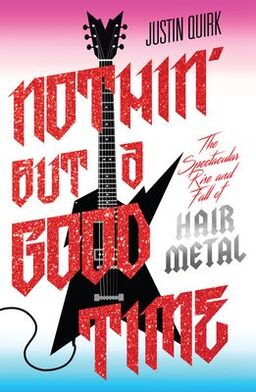
Nothin' but a good time : the spectacular rise and fall of glam metal
Justin QuirkQuirk, Justin Bok Engelsk utgitt 2020
Ledig
- Sølvberget, 3. etasje Musikk: 1 av 1 ledig
Plassering: musikkbøker (sortering: 781.66 QUI)

*0010883909 *003NO-OsBA *00520211216071429.0 *007ta *008 s2020 e ||||||0| 0 eng|d *009 nam a22 c 4500 *019 $bl *020##$a9781789651355$cNkr 162.00$qheftet *035 $a(NO-LaBS)15593483(bibid) *035 $a(NO-OsBA)0641597 *040 $aNO-OsBA$bnob$erda *082 $a781.6609$qNO-OsBA$223/nor *090 $c781.66$dQUI *1001#$aQuirk, Justin$0(NO-TrBIB)1634286305925$4aut$81$_44496200 *24510$aNothin' but a good time$bthe spectacular rise and fall of glam metal$cJustin Quirk *264 $aLondon$bUnbound$c2020 *300##$axxii, 291 sider *336##$atekst$0http://rdaregistry.info/termList/RDAContentType/1020$2rdaco *337##$auformidlet$0http://rdaregistry.info/termList/RDAMediaType/1007$2rdamt *338##$abind$0http://rdaregistry.info/termList/RDACarrierType/1049$2rdact *386##$aEngelskmenn$beng.$mNasjonalitet/regional gruppe$2bibbi$81 *386##$am$mKjønn$811 *520 $aFrom 1983 until 1991, Glam Metal was the sound of American culture. Big hair, massive amplifiers, drugs, alcohol, piles of money and life-threatening pyrotechnics. This was the world stalked by Bon Jovi, Kiss, W.A.S.P., Skid Row, Dokken, Motley Crue, Cinderella, Ratt and many more. Armed with hairspray, spandex and strangely shaped guitars, they marked the last great era of supersize bands. Where did Glam Metal come from? How did it spread? What killed it off? And why does nobody admit to having been a Glam Metaller anymore? *546##$aEngelsk tekst *650 7$aGlamrock$xHistorie$0(NO-OsBA)1143406$9nno$2bibbi$_44496300 *650 7$aGlamrock$xHistorie$0(NO-OsBA)1143406$9nob$2bibbi$_44496400 *8521#$h781.6$iQ *856##$aaja.bs.no$qimage/jpeg$uhttps://aja.bs.no/db908d14-2f8d-4685-bf79-63594ca02404/cover/original.jpg$3Omslagsbilde *856##$aaja.bs.no$qimage/jpeg$uhttps://aja.bs.no/db908d14-2f8d-4685-bf79-63594ca02404/cover/thumbnail.jpg$3Miniatyrbilde ^